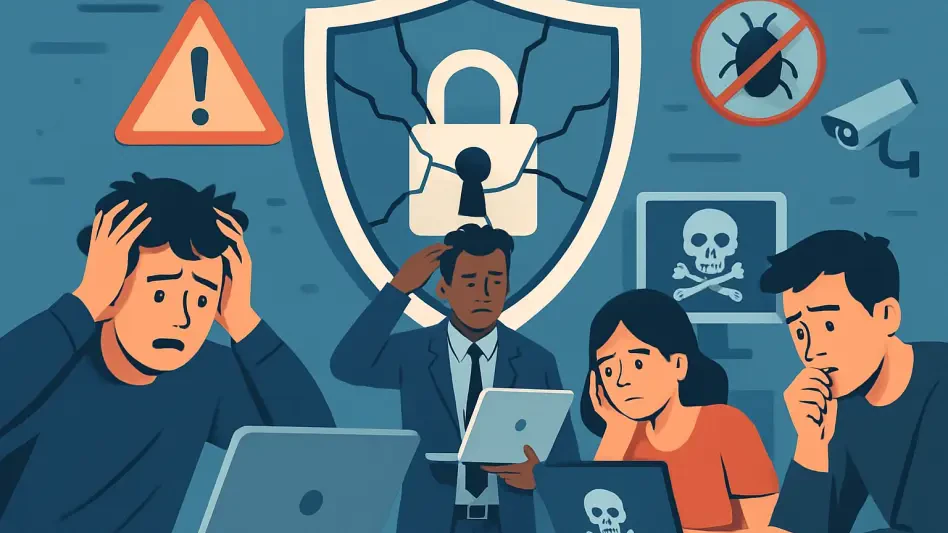In an era where digital threats loom larger than ever, the world faces a profound challenge: a severe shortage of cybersecurity professionals at a time when cybercrime is escalating at an alarming rate. Every day, organizations—from small businesses to government agencies—battle sophisticated attacks that jeopardize not only financial stability but also the very infrastructure that keeps society functioning, such as power grids and transportation systems. The global deficit of skilled cyber defenders stands at a staggering five million roles, leaving countless positions vacant and systems dangerously exposed. This glaring gap has turned into a national and international emergency, as the frequency and complexity of attacks continue to outpace the ability to respond. Delving into the heart of this crisis, the discussion must focus on actionable strategies to cultivate a new generation of talent capable of standing firm against these relentless digital threats.
Understanding the Depth of the Talent Shortage
The cybersecurity talent shortage represents a critical vulnerability that transcends a mere hiring challenge, emerging as a full-blown national emergency. In the United States alone, hundreds of thousands of positions remain unfilled, while the global gap stretches into the millions, creating a workforce crisis of unprecedented scale. Overburdened teams struggle to keep pace with cybercriminals who strike with such frequency that the situation can be compared to bandits raiding understaffed banks at a relentless rate. This scarcity of skilled professionals leaves businesses, governments, and individuals exposed to devastating breaches that can disrupt operations and erode trust. The urgency to address this shortfall cannot be overstated, as each vacant role represents a potential entry point for malicious actors. Bridging this gap requires not just recruitment but a fundamental rethinking of how talent is identified, trained, and deployed to fortify digital defenses against an ever-growing threat landscape.
Beyond the raw numbers, the talent shortage exacerbates the strain on existing cybersecurity teams, pushing them to their limits in an environment of constant pressure. Many professionals face burnout as they attempt to cover vast responsibilities with limited resources, often working long hours to monitor and respond to threats. This unsustainable workload compromises the effectiveness of defenses, allowing attackers to exploit weaknesses that might otherwise be mitigated. The ripple effects extend to organizational resilience, as understaffed teams may miss critical vulnerabilities or fail to implement timely updates to security protocols. Addressing this crisis demands a multifaceted approach that not only fills open positions but also supports current staff through better tools, training, and workload management. Without such interventions, the gap will continue to widen, leaving society increasingly vulnerable to the next wave of digital assaults.
Confronting the Escalating Threat of Cybercrime
Cybercrime has evolved into a pervasive and costly menace, draining hundreds of billions from the U.S. economy annually, with projections estimating losses could reach a trillion dollars in the near future. The pace of attacks is staggering, with forecasts suggesting major incidents could occur every two seconds by 2031, highlighting the relentless nature of this digital onslaught. Beyond the financial toll, the implications for national security are profound, as hackers target critical systems that underpin daily life, from energy grids to transportation networks. These threats, often orchestrated by organized crime syndicates and state-sponsored actors, exploit every opportunity to cause disruption on a massive scale. Building a robust cybersecurity workforce is no longer optional but a fundamental necessity to safeguard economic stability and societal well-being against an adversary that shows no signs of slowing down.
The sophistication of cyber threats adds another layer of complexity to this crisis, as attackers employ advanced tactics to bypass even the most fortified defenses. From ransomware that locks organizations out of their own systems to phishing schemes that trick employees into revealing sensitive information, the arsenal of cybercriminals is both diverse and adaptive. This constant evolution means that defenders must anticipate not just current threats but also emerging ones that could exploit new technologies or vulnerabilities. The potential for catastrophic damage—such as a breach in a nuclear facility or a major utility provider—underscores the high stakes involved. Developing talent capable of countering these dangers requires a focus on both technical expertise and strategic foresight, ensuring that the next generation of professionals can protect against risks that are as unpredictable as they are destructive.
Navigating the Arms Race of Digital Threats
The landscape of cybersecurity is defined by a relentless arms race, where cyber threats evolve at a breakneck pace, often fueled by cutting-edge tools like artificial intelligence that enable attackers to identify and exploit system weaknesses with precision. This dynamic creates an ongoing showdown between defenders and malicious actors, where threats transform and adapt much like a biological virus, demanding constant vigilance and innovation from those tasked with protection. Every role in the field, from entry-level analysts monitoring alerts to seasoned experts designing defense strategies, must remain agile in response to this ever-shifting battleground. The challenge lies in cultivating a workforce that can not only react to current dangers but also anticipate future ones, staying a step ahead in a conflict where the rules and tactics change daily. Without such adaptability, the risk of falling behind grows exponentially.
Moreover, the arms race extends beyond technology to the very mindset of cybersecurity professionals, who must think like their adversaries to predict and prevent attacks. This requires a deep understanding of attacker motivations, whether driven by financial gain, political agendas, or sheer disruption. Training programs need to emphasize creative problem-solving and ethical hacking skills, equipping individuals to test systems for weaknesses before they can be exploited. The integration of real-time threat intelligence into daily operations also becomes crucial, allowing teams to respond to emerging risks with speed and accuracy. Building this level of expertise across all levels of the workforce is a daunting task, yet it remains essential to maintaining a proactive stance in a field where reactive measures often fall short. The focus must shift toward fostering resilience through continuous learning and strategic preparation.
Revolutionizing Education for Cybersecurity Readiness
The current pace of training in cybersecurity is failing to meet the urgent demands of the crisis, leaving many graduates unprepared for the practical challenges they face upon entering the workforce. Employers often hesitate to hire candidates lacking real-world experience, creating a bottleneck that hinders the influx of new talent. Higher education institutions must overhaul curricula to align with rapid technological advancements, ensuring that students gain relevant skills that match industry needs. Simultaneously, upskilling individuals already working in IT roles offers a faster path to bolstering the workforce, leveraging existing knowledge to address immediate gaps. Stronger collaboration between academia and industry is vital to create pathways that deliver graduates who are not just theoretically proficient but ready to tackle live threats from day one, closing the disconnect between classroom learning and workplace demands.
Another critical aspect of educational reform lies in integrating hands-on learning opportunities that mirror the complexities of actual cybersecurity environments. Traditional lecture-based approaches fall short in preparing students for the unpredictable nature of cyber threats, where split-second decisions can make the difference between a contained incident and a catastrophic breach. Programs that incorporate labs, simulations, and mentorship from seasoned professionals can provide invaluable exposure to the pressures and intricacies of the field. Additionally, fostering partnerships with tech companies allows for curriculum updates that reflect the latest tools and attack vectors, ensuring relevance in a fast-moving discipline. By prioritizing practical readiness over theoretical knowledge alone, educational systems can produce a pipeline of talent equipped to handle the intense and dynamic challenges of defending digital landscapes.
Pioneering Training for Immediate Impact
Innovative training solutions are emerging as a beacon of hope in addressing the cybersecurity talent crisis, offering immersive experiences that prepare individuals for real-world challenges. Institutions like DeVry University have taken significant steps by collaborating with industry leaders to create simulated environments where students engage with realistic cyber threat scenarios, honing skills in analytics, investigation, and remediation. These platforms replicate the intensity of actual attacks, providing a safe space to learn from mistakes and build confidence. Such initiatives mark a shift toward experiential learning, ensuring that graduates possess not just knowledge but the ability to apply it under pressure. As the field continues to evolve at a rapid pace, these forward-thinking approaches are crucial to developing a workforce capable of immediate impact in defending against sophisticated threats.
Competitive platforms also play a transformative role in talent development, offering unique opportunities to test and refine skills in high-stakes settings. Events like the National Cyber League allow participants to engage in challenges that mirror real cyber defense tasks, earning recognition for their abilities on a national stage. These competitions foster a spirit of innovation and collaboration, encouraging participants to think critically and adapt to unexpected scenarios. Beyond skill-building, they serve as a bridge to industry, connecting promising talent with employers seeking capable defenders. By investing in such programs, stakeholders can accelerate the growth of a skilled workforce ready to tackle the complexities of modern cyber threats. This focus on practical, competitive training reflects a broader understanding that readiness is not just about education but about cultivating resilience and agility in the face of relentless digital adversaries.
Forging a Path Forward Through Collaboration
Reflecting on the cybersecurity crisis, it’s evident that the talent shortage and escalating threats demand urgent and coordinated responses from all sectors. Governments, private industries, and educational bodies have collaborated in the past to lay the groundwork for impactful solutions, recognizing that no single entity can address this emergency alone. Partnerships formed to align training with industry needs have proven instrumental in preparing graduates for immediate challenges. Simulated environments and competitive platforms have become cornerstones of talent development, equipping individuals with hands-on experience to counter sophisticated attacks. These efforts mark significant progress in building a resilient workforce, demonstrating the power of collective action in fortifying digital defenses against a backdrop of constant danger.
Looking ahead, the next steps involve scaling these initiatives to reach broader audiences, ensuring that innovative training and educational reforms become accessible to diverse talent pools. Investment in technology that supports remote learning and virtual simulations can democratize access to high-quality programs, breaking down geographical and financial barriers. Additionally, policymakers should prioritize incentives for entering the cybersecurity field, such as scholarships or loan forgiveness for students pursuing relevant degrees. Industry leaders must continue to provide mentorship and internship opportunities, creating clear pathways from education to employment. By sustaining and expanding these collaborative frameworks, society can cultivate a robust pipeline of cyber defenders ready to protect critical systems and maintain trust in an increasingly digital world.








